
|
|
BIOGRAPHY
|
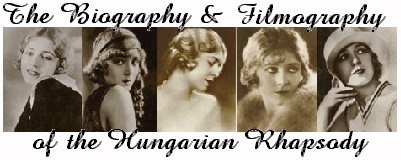
Lonchit or Longit or the like, but I have found few definite sources that list her name as so.) Birthdate & place: January 09, 1902*, Nagydorog, Hungary Spouse: Rod la Rocque from 1927-1969 Death: March 18, 1991, Los Angeles, California
Prior to Vilma BankyÂ’s birth, her father, a
highly esteemed bureau chief for the Franz Josef Austro-Hungarian
Empire, had moved the family to the small town of Nagyrodog, a suburb
of Budapest, in Hungary. Vilma Konsics Bánky was born there on
January 09, 1902* (This date, after much research,
seems to be correct. Numerous sources validate that Vilma was born in
1902 not 1898 as widely thought.) Johann Konsics Bánky, her father, was a
man of considerable wealth before World War I. Multiple
sources confirm that none of her family was in any way connected with the
stage. (Some sources have said that her mother, Katalin Ulbert,
had been a famous Hungarian stage star. Another rumor flying around when
Vilma arrived in America in March 1925 was that Vilma was a countess, but
this is also not true, she just came from a "private" family.)
At the time of VilmaÂ’s birth, in 1902, her two siblings,
brother Gyula and sister Agnes (or Gizi), had already been born. Budapest was not
far from their home in rural Nagyrodog where Vilma was born. The Bánky
family moved to Budapest around 1906. Bánky had definite plans for
VilmaÂ’s future. Marriage and housewifely duties would suit her best.
He decided to send her to a prominent school in the heart of the capitol.
Here, her father was assured, Vilma would learn all the proper activities
of a good wife and mother. She was taught languages, handwork (she
excelled at needlepoint), etc. and how to carry herself like a lady.
Prior to World War I, the Bánky family was quite prominent – Vilma’s
father held large tracts of land, grand houses, and all the luxuries
afforded them. The Great War stripped the Banky family of most of their
belongings. They were not accustomed to such poor living conditions – and
for the first time, Vilma knew what hunger really was. The impact
left on Vilma was enormous.
In Hollywood, reporters would remark on her quiet
and almost painfully serious demeanor. She was forced to focus on her
goals in order to support both herself and her family.
Rise to Fame for "The Hungarian Rhapsody"
With the final preparations made, Vilma sailed to America from Southampton,
England. The Aquitania docked in the New York City harbor on March 10, 1925
to much fanfare. Her arrival had been expected and an entourage from the
movie magazines and the press were present. Vilma still knew little English,
perhaps only a few words, yet it was touted that Goldwyn had taught her to
say “lamb chops and pineapple” in response to the reporters’ questions.
Curiously enough, upon her arrival, the New York Times quotes her as saying
(obviously via the aid of an interpreter), “it is a matter of little
consequence what I think or say. There are too many stars traveling who
do nothing but talk. I don’t want to be one of them”. Vilma was most
likely overwhelmed with all of the publicity and attention she was receiving.
On the Continent, as it was frequently referred to, she had preferred and
enjoyed the privacy to which she was accustomed. She had always had a
bashful, almost withdrawn personality that would continue till her death.
Vilma was scheduled for a brief stay in New York City before her
departure for Hollywood. She was at the time still being bombarded by
the incessant inquiries from fan magazines. Numerous rumors surrounded
VilmaÂ’s life as soon as she stepped off the boat. Many believed that
Vilma was a countess or of some noble birth, but she always claimed that
her family were simply “private people.” Her lack of English skills made
the interviews no doubt difficult, but Vilma, being trained on both the
stage and in film, possessed a unique talent for pantomime. However, the
press mostly made note of Vilma’s pulchritude and charm. A Hungarian! –
And blonde at that!
One contemporary magazine describes the newly arrived beauty:
"[s]he is quite marvelously lovely to look at. A fairy-
tale princess come to life. And this despite the fact that
she does not remind me of Our Mary. No, nor of Lillian
Gish, nor of any other stellar beauty mine eyes have
yet beheld. She is taller and altogether larger than Our
Mary. She has lovely, corn-silk hair, simply parted in the
middle and rolled in the nape of her neck. She has milk-
white skin and wide, sweetly-expressioned blue eyes.
Perfect teeth, a charmingly warm, not too-small mouth.
She doesnÂ’t look like any stereotyped conception of an
actress. She looks as though she came from “just a
private family.” Her previous stage and screen
experiences have left no slightest trace. She is as fresh
as May, as ethereal as Mab and as wholesome, withal, as
roses and cream. She is sweet with simplicity and
delicious with lack of pose. She has a gentle, tender sort
of voice." (Movie Weekly, PG. 4 – 5, “Miss Banky from Budapest”, by Faith Service, April 18, 1925)
She immediately felt ostracized by the film community. So much publicity
and hype had followed Vilma to Hollywood it is possible that Hollywood felt
a little slighted by the media, and no one but Norma Talmadge attempted to
befriend her on her arrival. Besides loneliness and homesickness, she was
also experiencing somewhat of a culture shock. The War had taught Vilma
frugality and it was to her great surprise to see such reckless spending
in Hollywood. She was earning a larger income than she had in Berlin, but
the money did not seem to stretch as far. In Berlin, she had lived in
luxury in a large suite with several servants, but in Hollywood could only
afford “a small bungalow and one servant.” Commenting on the prices of
American items, she said during an interview, “What I must pay for a simple
dinner would support a family in my country for a week! When I translate the
price tags on everything in this place into kronen, I am horrified. It seems
sinful to give so much for so little.”
When Vilma arrived in Hollywood, she was dubbed by Goldwyn publicists
as "The Hungarian Rhapsody". A very appropriate title! Vilma spoke no
English when she first came and though she was determined to learn it in the
early years, she had trouble grasping the language and expelling her
thick Hungarian accent.
As soon as she arrived, Samuel Goldwyn was anxious to star his
latest (and greatest!) discovery in The Dark Angel. Goldwyn had been
sure to boast and praise Vilma Banky to all the Hollywood columnists.
Everyone
apparently on the set was overwhelmed with Vilma's beauty, as she was also
extensively promoted as "The Most Lovely Woman on the Screen".
The Dark Angel was a sensational hit. Its success assured Goldwyn that
Vilma was both able to act and would indeed be a profitable asset to the
studio. The New York Times praised her acting in this film
as did all the fan magazines, proclaiming that Vilma Banky was actually as
good as Samuel Goldwyn had claimed.
|
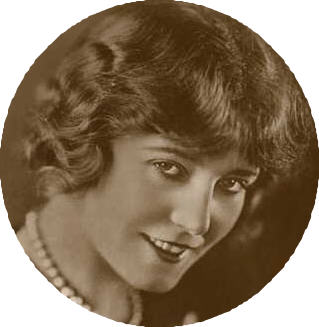
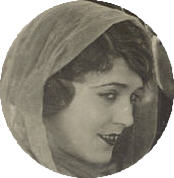
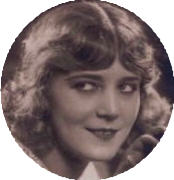 Vilma was renown for her beauty and grace and her friends suggested she take up acting.
Vilma, though, was bashful and extremely terrified of the "sea of strange
faces." A Hungarian motion
picture director, Bela Balogh, quite taken with Vilma's beauty, immediately
cast her in Im Letzten
Augenblick, in 1920. Her father disapproved highly of VilmaÂ’s
association with films. He felt his daughter would be best suited by
an early marriage and he had a fairly good idea of whom. A baron of a
large manor lived across the lake from the Banky estate – a young, very
wealthy man whom Vilma sincerely intended to marry well after her arrival
in Hollywood. It seems he was allied with the elder Bánky – he frowned
upon VilmaÂ’s current occupation. He felt that actors were beneath him
and had no qualms at letting Vilma know. Despite her invitation, he
refused to go to America with her for this very reason. Despite this,
she eventually gained popularity as a capable and exquisite
actress. She appeared in about twelve films - either Hungarian, Austrian,
French, or German - before being discovered in 1925 by Samuel Goldwyn. He had seen a
picture postcard of Vilma in a shop when he arrived in Hungary. Goldwyn knew well
that she would be a hit and was so impressed that he set out to find the
fragile Hungarian beauty.
Until 1925, knowledge of VilmaÂ’s reputation as an actress existed
only in Europe. She was one of HungaryÂ’s most popular actors. Her last
film before coming to America, Soll Man Heiraten? (aka
Intermezzo Einer Ehe In Sieben Tagen), produced for Gloria Film,
a German company, was completed in early 1925. Samuel Goldwyn, the
famous producer for United Artists, had come to Europe.
The story of “Goldwyn’s Great Discovery” was frequently recounted by the
press after VilmaÂ’s arrival in America. The general consensus of the
writers agree that Goldwyn first became acquainted with the actress from
her picture he happened to see in a shopkeeperÂ’s window while on his
travels through Budapest. The details blur at this point and while
some accounts state that Goldwyn had never seen VilmaÂ’s acting
abilities until her screen test in America, others say that Goldwyn
saw both stills and examples of her work. Regardless, Goldwyn was
interested in Vilma and made every effort to locate her. He found
himself facing closed doors in his attempts and could not seem to
contact her – even by telephone. The company in Budapest for which
she was currently working, Gloria Film, was determined to keep Vilma
from meeting with Goldwyn. They had already drawn up a contract and
were continually pushing Vilma to sign. Vilma would later wonder what
kept her from signing it; perhaps she was getting wind of the news by now.
Gloria Film kept her working day and night to prevent her meeting with
Goldwyn. Fortunately for Vilma, someone alerted her and told her that
Goldwyn was leaving that night. He had given up for the time being and
decided to return to America. With all the drama of a true Hollywood
movie, Vilma was said to have raced in a mad dash to the train station
without removing her costume or make-up and caught him by the coat tails
just as he was passing through the gate. Goldwyn and Vilma had dinner
together and that same night, Vilma was offered an American contract,
which she eagerly accepted.
Vilma yearned for stardom of great magnitude, and although she had
achieved it in Europe, she saw America as a new challenge.
Bucking traditional values and against her parentsÂ’ wishes, she had
made the decision to leave for America. She placed her trust in GoldwynÂ’s
promises that she would be a great star, but she was unaware of just how
difficult the transition would be.
Vilma was renown for her beauty and grace and her friends suggested she take up acting.
Vilma, though, was bashful and extremely terrified of the "sea of strange
faces." A Hungarian motion
picture director, Bela Balogh, quite taken with Vilma's beauty, immediately
cast her in Im Letzten
Augenblick, in 1920. Her father disapproved highly of VilmaÂ’s
association with films. He felt his daughter would be best suited by
an early marriage and he had a fairly good idea of whom. A baron of a
large manor lived across the lake from the Banky estate – a young, very
wealthy man whom Vilma sincerely intended to marry well after her arrival
in Hollywood. It seems he was allied with the elder Bánky – he frowned
upon VilmaÂ’s current occupation. He felt that actors were beneath him
and had no qualms at letting Vilma know. Despite her invitation, he
refused to go to America with her for this very reason. Despite this,
she eventually gained popularity as a capable and exquisite
actress. She appeared in about twelve films - either Hungarian, Austrian,
French, or German - before being discovered in 1925 by Samuel Goldwyn. He had seen a
picture postcard of Vilma in a shop when he arrived in Hungary. Goldwyn knew well
that she would be a hit and was so impressed that he set out to find the
fragile Hungarian beauty.
Until 1925, knowledge of VilmaÂ’s reputation as an actress existed
only in Europe. She was one of HungaryÂ’s most popular actors. Her last
film before coming to America, Soll Man Heiraten? (aka
Intermezzo Einer Ehe In Sieben Tagen), produced for Gloria Film,
a German company, was completed in early 1925. Samuel Goldwyn, the
famous producer for United Artists, had come to Europe.
The story of “Goldwyn’s Great Discovery” was frequently recounted by the
press after VilmaÂ’s arrival in America. The general consensus of the
writers agree that Goldwyn first became acquainted with the actress from
her picture he happened to see in a shopkeeperÂ’s window while on his
travels through Budapest. The details blur at this point and while
some accounts state that Goldwyn had never seen VilmaÂ’s acting
abilities until her screen test in America, others say that Goldwyn
saw both stills and examples of her work. Regardless, Goldwyn was
interested in Vilma and made every effort to locate her. He found
himself facing closed doors in his attempts and could not seem to
contact her – even by telephone. The company in Budapest for which
she was currently working, Gloria Film, was determined to keep Vilma
from meeting with Goldwyn. They had already drawn up a contract and
were continually pushing Vilma to sign. Vilma would later wonder what
kept her from signing it; perhaps she was getting wind of the news by now.
Gloria Film kept her working day and night to prevent her meeting with
Goldwyn. Fortunately for Vilma, someone alerted her and told her that
Goldwyn was leaving that night. He had given up for the time being and
decided to return to America. With all the drama of a true Hollywood
movie, Vilma was said to have raced in a mad dash to the train station
without removing her costume or make-up and caught him by the coat tails
just as he was passing through the gate. Goldwyn and Vilma had dinner
together and that same night, Vilma was offered an American contract,
which she eagerly accepted.
Vilma yearned for stardom of great magnitude, and although she had
achieved it in Europe, she saw America as a new challenge.
Bucking traditional values and against her parentsÂ’ wishes, she had
made the decision to leave for America. She placed her trust in GoldwynÂ’s
promises that she would be a great star, but she was unaware of just how
difficult the transition would be.
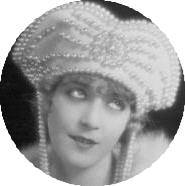 Vilma, not knowing what had hit her, sailed for America. She
yearned for fame and stardom and knew that going to America would do the trick, but this
feeling would wane in later years.
Vilma, not knowing what had hit her, sailed for America. She
yearned for fame and stardom and knew that going to America would do the trick, but this
feeling would wane in later years.
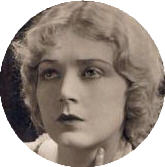 Vilma was signed to a contract beginning at $100 a week, which then
increased to $250, and eventually would escalate to $5,000 a week.
Vilma was signed to a contract beginning at $100 a week, which then
increased to $250, and eventually would escalate to $5,000 a week.
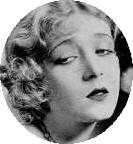 United Artists then co-starred Vilma
with Rudolph Valentino in The Eagle in 1925. During the making of this
movie, Vilma and Rudolph became good friends; she provided a caring,
listening ear to his problems. They were then reunited in the exceedingly
successful and popular film, The Son of the Sheik in 1926. Tragedy then
struck - Rudolph Valentino, one of the Hollywood's greatest died on August
23, 1926. Goldwyn immediately cast Vilma in The Winning of Barbara Worth,
along with Ronald Colman and by pure luck, the newcomer, Gary Cooper.
United Artists then co-starred Vilma
with Rudolph Valentino in The Eagle in 1925. During the making of this
movie, Vilma and Rudolph became good friends; she provided a caring,
listening ear to his problems. They were then reunited in the exceedingly
successful and popular film, The Son of the Sheik in 1926. Tragedy then
struck - Rudolph Valentino, one of the Hollywood's greatest died on August
23, 1926. Goldwyn immediately cast Vilma in The Winning of Barbara Worth,
along with Ronald Colman and by pure luck, the newcomer, Gary Cooper.
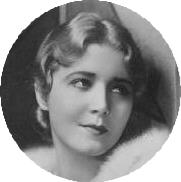 It was
another highly successful film that included sandstorms and a magnificent
flood scene. The Night of Love, a romantic period drama, was made in 1927 with the idolized love duo and was adored by the fans. In 1927, a very
extravagant wedding known as "The Social Event of 1927" occurred.
Vilma wed Rod la Rocque, a popular silent screen star idol, on
June 26. The wedding, paid for by Samuel Goldwyn, took place in
The Beverly Hills Church of the Good Shepherd and was packed
with all of the big Hollywood stars. After followed a wonderful reception. (Read more about
It was
another highly successful film that included sandstorms and a magnificent
flood scene. The Night of Love, a romantic period drama, was made in 1927 with the idolized love duo and was adored by the fans. In 1927, a very
extravagant wedding known as "The Social Event of 1927" occurred.
Vilma wed Rod la Rocque, a popular silent screen star idol, on
June 26. The wedding, paid for by Samuel Goldwyn, took place in
The Beverly Hills Church of the Good Shepherd and was packed
with all of the big Hollywood stars. After followed a wonderful reception. (Read more about